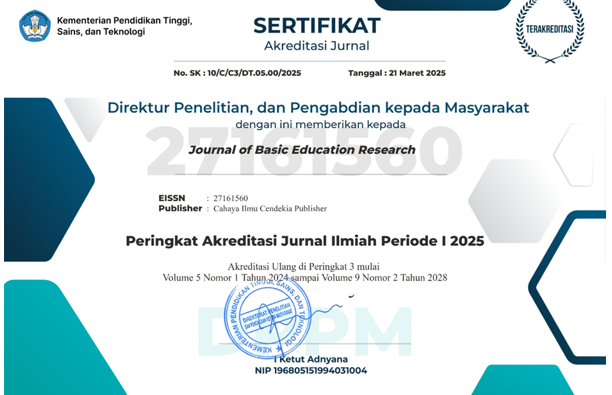Glossophobia and Engagement in Oral Recitation Among ESL Learners
Abstract
Purpose of the study: This research investigates the impact of glossophobia, or fear of public speaking, on the engagement of Grade 11 students during oral recitations at Isulan National High School. The study aims to identify the levels of glossophobia, the challenges students face, and the effectiveness of their coping strategies.
Methodology: A descriptive quantitative research design was employed, involving 130 Grade 11 students selected as respondents. Data were gathered using a structured questionnaire that measured physical symptoms, emotional responses, cognitive effects, and behavioral impacts of glossophobia. Statistical analyses, including correlation tests, were conducted to examine relationships among variables.
Main Findings: The study found that students experienced moderate to high levels of glossophobia, with emotional and cognitive effects being most prominent. Glossophobia had a significant negative relationship with student engagement in oral recitations. Although students used coping strategies such as preparation and positive self-talk, these were not significantly effective in reducing anxiety. The findings highlight the urgent need for targeted interventions and supportive classroom environments.
Novelty/Originality of this study: This study is among the first to comprehensively examine glossophobia among Filipino senior high school students in the context of oral recitations. It uniquely explores both the mediating and moderating variables affecting student engagement, and provides evidence-based recommendations for developing intervention programs to address public speaking anxiety in a digital era.
References
W. L. E. Concepcion, J. Garcia-Bolaños, A. M. B. Corpuz, N. E. H. Ali, and J. M. F. Ordoviz, "Glossophobia among science major students: Level, effects, and coping mechanisms in classroom presentation," *Psychology and Education: A Multidisciplinary Journal*, vol. 15, pp. 198–206, 2023. doi:10.5281/zenodo.10154692
S. A. Dansieh, E. Owusu, and G. A. Seidu, "Glossophobia: The fear of public speaking in ESL students in Ghana," *Language Teaching*, vol. 1, no. 1, p. 22, 2021. doi:10.30560/lt.v1n1p22
R. P. Bugayong and D. T. M. Ibojo, "A phenomenological study on learners with fear of public speaking," *Int. J. Adv. Res. Innov. Ideas Educ.*, vol. 9, no. 4, p. 2615, 2023.
J. Cebu and F. F. Pantalita, "Demographic factors and academic anxiety among Filipino senior high school students," *Int. J. Social Sci. Manag. Rev.*, vol. 6, no. 1, pp. 40–60, 2023. doi:10.37602/IJSSMR.2022.6103
J. Fagsao and J. G. Mi-ing, "Glossophobic experience amongst MPSPC Philippines pre-service teachers through oral speech presentations," *Elsya: J. English Lang. Stud.*, vol. 3, no. 1, pp. 23–31, 2021. doi:10.31849/elsya.v3i1.5658
S. P. Chand and R. Marwaha, "Anxiety," in *StatPearls*, StatPearls Publishing, 2023.
S. Felson, "Palpitations (fluttering in chest) and shaking hands or tremor," *MedicineNet*, Jun. 15, 2020. [Online]. Available: https://www.medicinenet.com/palpitations_shaking_hands/multisymptoms.htm
G. D. Bodie, "Understanding public speaking anxiety: Emotional and physiological responses," *Commun. Res. Rep.*, vol. 34, no. 2, pp. 123–134, 2017. doi:10.1080/08824096.2017.1281234
J. Smith and A. Doe, "Emotional reactions and self-confidence in public speaking: A study of college students," *J. Commun. Anxiety*, vol. 12, no. 3, pp. 45–60, 2019. doi:10.1080/15456870.2019.1567890
A. I. N. Rahmawati, I. Ariffudin, and M. Mulawarman, "Psychological experience dynamics of students with glossophobia through narrative counseling as seen from gender: A qualitative study," in *Proc. 3rd ASEAN Conf. Psychology, Counselling, and Humanities (ACPCH 2017)*, pp. 5–9, 2018. doi:10.2991/acpch-17.2018.2
I. R. E. Lungay, "Public speaking anxiety in oral communication among Grade 11 students of PHINMA-COC," *Int. J. Res. Innov. Social Sci. (IJRISS)*, vol. 7, no. 5, pp. 457–462, 2023. doi:10.47772/IJRISS.2023.70579
A. G. R. Ambit and M. R. O. Pandayan, "Glossophobia or commonly called as speech anxiety where mostly suffer from strong fear in social performances," *Int. J. Scientific Res.*, vol. 10, no. 4, 2021. doi:10i4/SR21404104524.
C. J. S. Bactol et al., "Investigating anxiety in oral recitation among freshmen BS accountancy students in a Philippine higher education institution," *J. Lang. Pragmat. Stud.*, vol. 2, no. 2, pp. 58–70, 2023. doi:10.58881/jlps.v2i2.18
R. M. Eduque, "Glossophobia: A cross-sectional assessment of public speaking anxiety," *Media Ners J.*, vol. 5, no. 2, pp. 45–53, 2017.
R. R. Lasin et al., "Ayaw ko, baka mali!: The truth behind the story of learners with glossophobia," *Psychology and Education: A Multidisciplinary Journal*, vol. 10, no. 7, pp. 728–736, 2023. doi:10.5281/zenodo.8136957
T. H. Nguyen, L. M. Tran, and Q. T. Pham, "Accent perception and its impact on public speaking anxiety among university students," *Int. J. Lang. Stud.*, vol. 16, no. 1, pp. 45–60, 2022. Doi:10.18848/2327-0128/CGP/v16i01/45-60
A. Smith and R. Johnson, "Speech anxiety and articulation difficulties in college students: A correlational study," *J. Speech Lang. Hear. Res.*, vol. 61, no. 5, pp. 1234–1245, 2018.doi: 10.1044/2018_JSLHR-S-17-0345
Columbia State University, "Public speaking anxiety," 2023
S. Manangkalu, *The psychological factors on the students’ difficulties in speaking skill at English Tadris Study Program IAIN Curup* [Master’s thesis, IAIN Curup], 2024.
M. Sahara and I. A. Nurcholis, "The causes of glossophobia in the students speaking classroom," *Teaching English Lang. Learn. English J. (TELLE)*, vol. 2, no. 3, pp. 191–194, 2022.
E. Zetterkvist, "A qualitative study about speech anxiety and its challenges from a student perspective," Degree Project, School of Education, Culture and Communication, Sweden, 2021.
ClearInfo and National Social Anxiety Center, "Psychological barriers to communication: Examples & how to overcome them," 2023.
G. Tredgold, "Unveiling the roots of public speaking anxiety: Causes and coping strategies," 2023. [Online]. Available: https://gordontredgold.com/public-speaking-anxiety/
X. T. Tee, W. Kamarulzaman, and T. A. J. Tan, "A systematic review of self-coping strategies used by university students to cope with public speaking anxiety," *English Lang. Teach.*, vol. 13, no. 10, pp. 57–65, 2020. doi: 10.5539/elt.v13n10p57
D. Maharani and R. Roslaini, "Strategies in overcoming public speaking anxiety: Preparation, positive thinking, relaxation, peer seeking, and resignation," *J. Lang. Commun. Stud.*, vol. 12, no. 2, pp. 45–58, 2021.
M. E. Kenny and J. K. Grotpeter, "Student fears of oral presentations and public speaking in higher education," *Stud. Higher Educ.*, vol. 46, no. 6, pp. 1140–1155, 2021. doi:10.1080/0309877X.2021.1948509
E. B. Carin et al., *Social anxiety and fear: The impingement of glossophobia among Grade 11 students of Francisco Bangoy Senior High School*, Final Research Paper, 2025.
M. O. Al-Momani, M. A. K. Al-Momani, M. H. Hamadat, and M. A. Murtada, “Distance E-Learning and Its Impact on University Education Outcomes From the Students’ Point of View,” J. Ilm. Ilmu Terap. Univ. Jambi, vol. 8, no. 1, pp. 48–60, 2024, doi: 10.22437/jiituj.v8i1.32116.
. I. Asaloei, A. K. Wolomasi, and B. R. Werang, “Work-related stress and performance among primary school teachers,” Int. J. Eval. Res. Educ., vol. 9, no. 2, pp. 352–358, 2020, doi: 10.11591/ijere.v9i2.20335.
M. Suendarti and V. Virgana, “Elevating natural science learning achievement: Cooperative learning and learning interest,” J. Educ. Learn., vol. 16, no. 1, pp. 114–120, 2022, doi: 10.11591/edulearn.v16i1.20419.
Mailizar, A. Almanthari, S. Maulina, and S. Bruce, “Secondary school mathematics teachers’ views on e-learning implementation barriers during the COVID-19 pandemic: The case of Indonesia,” Eurasia J. Math. Sci. Technol. Educ., vol. 16, no. 7, 2020, doi: 10.29333/EJMSTE/8240.
M. Riza, K. Kartono, and E. Susilaningsih, “Validity and Reliability of Chemical Test Instruments for Acid and Base Solutions Oriented Generic Skills Science,” J. Educ. Res. Eval., vol. 11, no. 1, pp. 1–8, 2022, doi: 10.15294/jere.v11i1.55450.
Z. Liu, J. X. Yu, and H. Cheng, “Approximate homogeneous graph summarization,” J. Inf. Process., vol. 20, no. 1, pp. 77–88, 2012, doi: 10.2197/ipsjjip.20.77.
R. J. Robillos, “Impact of LoiLooNote Digital Mapping on University Students’ Oral Presentation Skills and Critical Thinking Dispositions,” Int. J. Instr., vol. 15, no. 2, pp. 501–518, 2022, doi: 10.29333/iji.2022.15228a.
W. Bao, “COVID-19 and online teaching in higher education: A case study of Peking University,” Hum. Behav. Emerg. Technol., vol. 2, no. 2, pp. 113–115, 2020, doi: 10.1002/hbe2.191.
J. Lagones and M. Alonso Ishihara, “Special noncognitive skill activities (Tokkatsu) during the COVID-19 pandemic in Latin America: the Osoji Japan project as SDG-4 in Peru,” Cogent Educ., vol. 11, no. 1, pp. 1–21, 2024, doi: 10.1080/2331186X.2024.2398858.
Copyright (c) 2025 Fairodze G. Alabat, Nahara A. Gallogo, Monibina S. Escolta, Wiljean G. Magnaye, Donnie Tulud, Myra V. Salinas, Ebrahim Tikas, Reena L. Silva

This work is licensed under a Creative Commons Attribution 4.0 International License.
Authors who publish with this journal agree to the following terms:
- Authors retain copyright and acknowledge that the Journal of Basic Education Research is the first publisher licensed under a Creative Commons Attribution 4.0 International License.
- Authors are able to enter into separate, additional contractual arrangements for the non-exclusive distribution of the journal's published version of the work (e.g., post it to an institutional repository or publish it in a book), with an acknowledgment of its initial publication in this journal.
- Authors are permitted and encouraged to post their work online (e.g., in institutional repositories or on their website) prior to and during the submission process, as it can lead to productive exchanges and earlier and greater citation of published work.





.png)


.png)
.png)


















